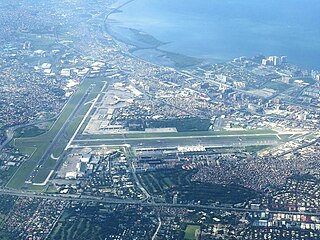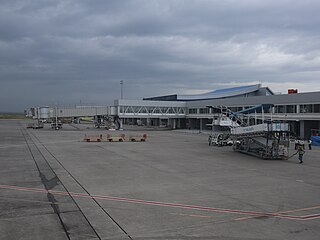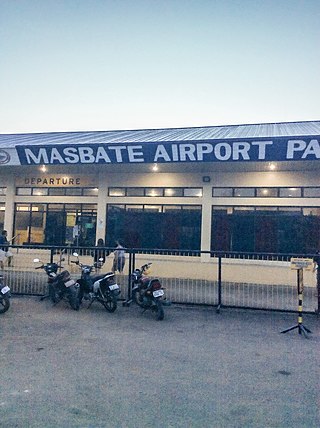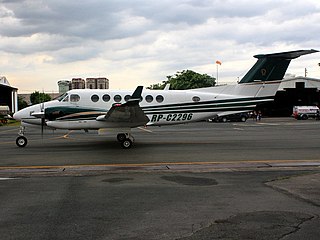
Ninoy Aquino International Airport, also known as Manila International Airport (MIA), is the main international airport serving Metro Manila in the Philippines. Located between the cities of Pasay and Parañaque, about 7 kilometers (4.3 mi) south of Manila proper and southwest of Makati, it is the main gateway for travelers to the Philippines and serves as a hub for PAL Express and Philippine Airlines. It is also the main operating base for AirSWIFT, Cebgo, Cebu Pacific, and Philippines AirAsia.

Legazpi Airport was a major airport in the Bicol Region, served the vicinity of Legazpi, the capital city of Albay in the Philippines.

Cebu Air, Inc., operating as Cebu Pacific, is a Philippine low-cost airline based at Pasay in Metro Manila. Founded in 1988, the airline was the first low-cost carrier in Asia and is also the largest airline in the Philippines. It offers scheduled flights to both domestic and international destinations. The airline operates flights from five bases in Cebu, Clark, Davao, Iloilo, and its largest base in Manila.

Zest Airways, Inc., operated as AirAsia Zest, was a Filipino low-cost airline based at Ninoy Aquino International Airport in Pasay, Metro Manila in the Philippines. It operated scheduled domestic and international tourist services, mainly feeder services linking Manila and Cebu with 24 domestic destinations in support of the trunk route operations of other airlines.

Cebgo, Inc., operating as Cebgo, is the wholly-owned regional subsidiary of Cebu Pacific. It is the successor company to South East Asian Airlines and Tigerair Philippines. It is now owned by JG Summit, the parent company of Cebu Pacific which operates the airline. The airline's main base has been transferred from Clark International Airport in Angeles City to Ninoy Aquino International Airport in Metro Manila. On April 30, 2017, Cebgo planned to move out from Manila and transfer its main base to Mactan–Cebu International Airport in Cebu City because NAIA has already maxed out its capacity. Currently, it operates an all-ATR fleet, with a total of 16 in service.

General Santos International Airport, also known as Tambler Airport and General Santos City Airport, is an alternate international airport located in the city of General Santos, Philippines serving the greater area of Soccsksargen. Situated in Fatima, General Santos, it is a large airport on the island of Mindanao and is officially classified as an international airport by the Civil Aviation Authority of the Philippines (CAAP), a government bureau which is responsible for the management and operations of General Santos International Airport and all other airports in the country except regular international airports.

Loakan Airport serves the general area of Baguio, Philippines. It is classified as a Class 2 principal airport by the Civil Aviation Authority of the Philippines (CAAP). Loakan Airport, the city's only airport, was built in 1934. Its short runway, frequent low visibility, and deep ravines at both ends of the runway continue to challenge pilots greatly, especially when it comes to landing.

Moises R. Espinosa Airport, also known as Masbate Airport, is the airport serving the general area of Masbate City, located in the province of Masbate in the Philippines. It is named for Moises R. Espinosa Sr., a former Representative of Masbate who was assassinated at the airport on March 17, 1989.

Naga Airport is an airport serving the city and metropolitan area of Naga, located in the province of Camarines Sur in the Philippines. Although the airport is named after Naga, it is actually located in the provincial capital, Pili. The airport is classified as a Class 1 principal airport by the Civil Aviation Authority of the Philippines, a body of the Department of Transportation (DOTr) that is responsible for the operations of not only this airport but also of all other airports in the Philippines except the major international airports.

Sayak Airport, commonly known as Siargao Airport, is the main airport serving Siargao Island located in Del Carmen, Surigao del Norte, Philippines. The airport is designated as a Class 2 principal airport by the Civil Aviation Authority of the Philippines (CAAP).
Air Philippines Corporation, operating as PAL Express and formerly branded as Air Philippines and Airphil Express, is a wholly-owned subsidiary airline of Philippine Airlines. It is PAL's regional brand, with services from its hubs in Manila, Clark, Cebu, and Davao.

Plaridel Airport is an airport serving the general area of Plaridel, located in the province of Bulacan in the Philippines. The Civil Aviation Authority of the Philippines, a body of the Department of Transportation that is responsible for the operations for 81 out of 85 government-owned airports, manages the facility and classifies it as a community airport.

Jesus "Jesse" Manalastas Robredo was a Filipino politician who served as 23rd Secretary of the Interior and Local Government in the administration of President Benigno Aquino III from 2010 until his death in 2012. Robredo was a member of the Liberal Party.

Aviatour's Fly'n, Inc., operating as Aviatour, was a charter airline with its corporate headquarters in the general aviation area of Mactan–Cebu International Airport, Lapu-Lapu, Central Visayas, Philippines. It operates air taxi services and charter flights in the Visayas. Its charter service includes sightseeing tours among islands in the Visayas and Mindanao.

Bingit (transl. brink) is a 2013 Philippine television docudrama anthology series broadcast by GMA Network. Directed by Rico Gutierrez and Lem Lorca, it premiered on September 21, 2013 on the network's Sabado Star Power sa Hapon line up. The series concluded on November 16, 2013 with a total of 9 episodes.

Mactan–Cebu International Airport (MCIA) is the main international airport serving Metro Cebu; it serves as the main gateway to the Central Visayas region in the Philippines. Located on a 797-hectare (1,970-acre) site in Lapu-Lapu City on Mactan, it is the second busiest airport in the Philippines. Opened on April 27, 1966, the airport serves as a hub for Philippine Airlines, and as an operating base for Cebu Pacific, Philippines AirAsia, and Sunlight Air.

XiamenAir Flight 8667 was a scheduled international passenger flight from Xiamen Gaoqi International Airport in Xiamen, China, to Ninoy Aquino International Airport in Manila, Philippines. On 16 August 2018, the Boeing 737-85C (WL) operating this flight skidded off the runway while attempting to land in poor weather conditions. After leaving the runway, the aircraft hit obstacles that tore off the left engine and the left main gear. The crash occurred at 11:55 p.m. Philippine Standard Time (UTC+8), and resulted in the destruction of the aircraft. No serious injuries were reported among the crew or passengers. The damaged aircraft took 36 hours to remove from the runway, leading to a major disruption at the airport, which is the primary international gateway to the Philippines. The closure caused the cancellation of more than 200 domestic and international flights, affected more than 250,000 travelers, and prompted calls for enlargement of the airport or the construction of alternative airports to serve the country in the event of future disruptions.

On September 1, 2019, a Beechcraft King Air 350 crashed into a tourist resort in Calamba, Laguna, Philippines while performing a medevac flight from Dipolog to Manila. All nine occupants aboard were killed in the crash.

Korean Air Flight 631 was a scheduled international passenger flight operating from Incheon International Airport near Seoul, South Korea to Mactan–Cebu International Airport in Metro Cebu, Philippines. On 23 October 2022, the Airbus A330-300 operating this flight overran the runway while landing in Cebu due to a failure with the hydraulics system. Despite what reports described the accident as a "terrifying close call," all 173 passengers and crew members survived injury-free.



















